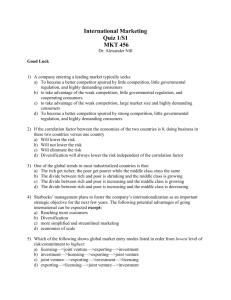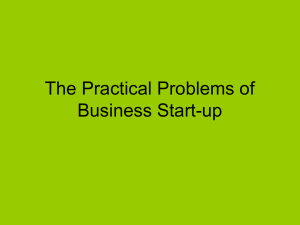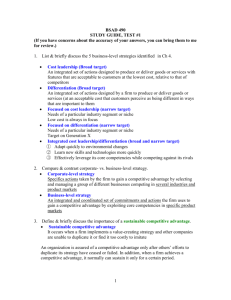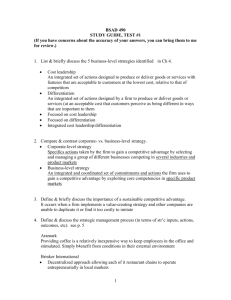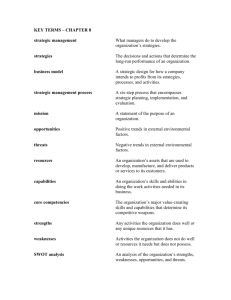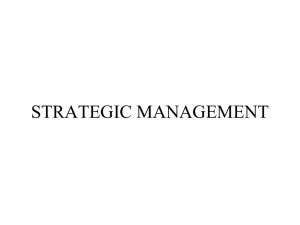strategic management and social responsibility
advertisement
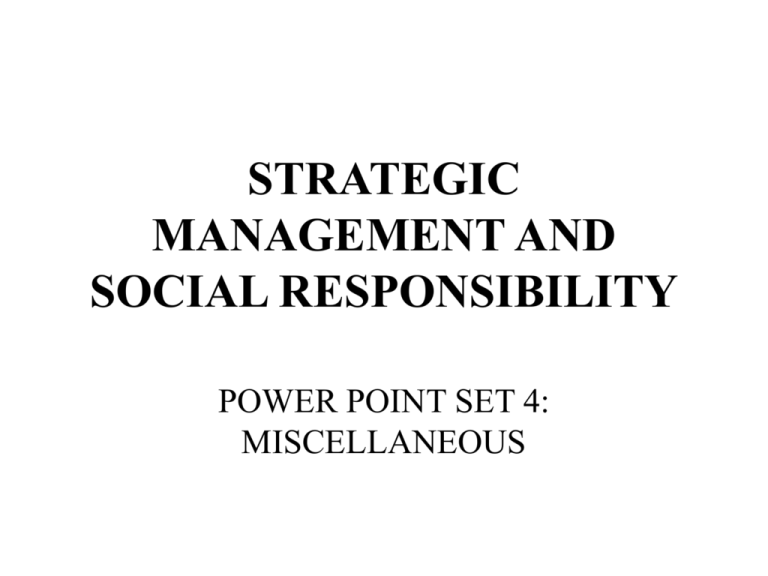
STRATEGIC MANAGEMENT AND SOCIAL RESPONSIBILITY POWER POINT SET 4: MISCELLANEOUS ROLE OF THE CEO • • • • • • • Strategist Mentor Visionary Guru Futurist Champion Leader AGENDA OF RESPONSIBILITIES Individuals (IT) Pre-Course - Bio & Picture Intro to Strategic Audit MINI CASE(s) As Assigned (S, S√, S√√) MIDI CASE - MID Term Exam (Letter Grade) Template Feedback Team Member Rating Constructive Comments [Peer Eval] - Maxi Case Optional: Strategic Plan -- Career Plan AGENDA OF RESPONSIBILITIES (Cont’d) PARTICIPATION TEAM (IT) Form Teams – Roles Weekly - Chapter Questions With key issues/answers email to Lead Discussion (Per Schedule) Maxi Case – Choice of company (approval) Prepare Report – Strategic Plan Template Present Strategic Plan MISC – Team Assignment – Micro Cases (B) MIDI Case: One (1), five (5) page (approximately), individually written case analysis (business plan) that must include: 1. Your mission for the future of the organization. 2. Your future objectives for the organization. 3. Your analysis and quantitative forecast of industry and company. 4. Your strategic decisions, i.e., actions, with results, to accomplish objectives. 5. A three (3) year pro forma income statement. 6. Your participation in class discussion and case debrief. TEAM STRATEGIC PLAN MAXI: A STRATEGIC PLAN that incorporates two efforts: Effort 1: A 25 Page Written Report (Approximately) Effort 2: Team Discussion/Presentation Effort 1: A 25 Page Written Report The following must be included in the strategic plan report: • • • • • • • • • • Future mission and objectives decided by you. Analysis and forecast of social, technical, economic, and political forces with attention to global aspects. Analysis of industry history and quantitative industry forecast on a global and domestic basis. Illustration and source of a share analysis. Evaluation of alternative strategies. Decision on strategic course showing basis and actions, with results, required to achieve indicated performance goals on each major strategic action Organizational process changes with schedules and budgets Pro-forma financial statements, I.e., cash flows balance sheets, and income statements to show impact of decision in the short-term, intermediate-term and long-term for a minimum of 5 years. Sufficient research, quantitative analysis, style, and organization to meet business planning standards. Typed, doubled spaced, table of contents, number pages, exhibits, and indicate sources. Effort 2: Team Discussion/Presentation • Each team must run a one (1) hour maximum discussion or presentation of the case. • The presenting team also indicates its role and audience role, both f which must be internal to the organization. • For intelligent participation in the team case discussions and to help in the selection of the third individual case, each team must provide one copy of each of the following materials to every class member and the instructor: Strategic Audit and Decision Making: A Structure • Context - Environmental/Industry • SLEPT (Social, Legal, Economic, Political, Technological) Forecast(s) – Company – Industry – History - Now/Future • Mission - All Stakeholders – Internal, Transactional, Influencers, Vision, Core Values, etc. • Objectives (Qualitative, Quantitative) – Drucker Model (8) (E) - Below STRUCTURE, CONT’D PERFORMANCE - Design/Audit System View (A) ADAPTIVE - 3 Questions What is Business? What will business be? [as is] What should business be? (E) EFFECTIVENESS (Drucker 8) Market Human Resources Innovation Financial Resources Profit Material Resources Societal Productivity (e) Efficiency Cost (versus) Quality Time Scope/Quantity SYSTEM VIEW (CONT’D) Global Dimensions (MACROECONOMICS - Global; Clusters/Culture; Comparative Advantages, etc) SWOT Internal S - Strengths W - Weakness [Core Competence] External O - Opportunity T - Threat PORTER’S ANALYSIS (Link to O.T.) National / Global Barriers to Entry Government Action Rivalry Among Competitors Barriers to Exit Power of Suppliers Power of Buyers Availability of Substitutes CONCLUSION: Attractive? STRATEGY FORMULATION 13 Strategic Options - Clusters 1. 2. 3. 4. 5. 6. 7. 8. Market Penetration Market Development Product Development Backward Integration Forward Integration Horizontal Integration Horizontal Diversification Vertical Diversification 9. Concentric Diversification 10. Conglomerate 11. Cooperative (Joint Venture) Strategic Alliance 12. Defensive - Retrenchment - Divestiture - Liquidation 13. Do Nothing Strategy Implementation and Control MIS System Corporate Leadership/Culture RE: Ongoing Process MGMT 450 STRATEGIC AUDIT FORMAT General Economy CONTEXT History You Now All Stakeholders MISSION Priorities OBJECTIVES (Personal|Professional) QUAL Quant (SUCCESS) ACTION(S) 3Q’s (A) e/E Future Formulation IMPLEMENTATION APPRAISAL TOOLS TECHNIQUES B\C RELEVANT ETC BEPOINT ISSUES RECOMMENDATIONS PRIORITIES Evaluation Control S W O T PORTER EVALUATION CONTROL REFORMULATION (REVISIT Model) DELPHI FORCASTING Q1. Q2. Q3. Q4. Estimate rate of inflation in the United States during next 12 months. ________% Estimate rate of unemployment in the United States during next 12 months. ________% Estimate prime rate for corporations in the United States during next 12 months. ________% Consumer confidence index in the United States during next 12 months. Use scale 1 to 10, with 10 highest ________% Strategic Management Information Knowledge vs. System 10% 90% Organization Level Planning Strategic External Information 40% It = Ik 90% 60% + Is 10% Control Internal Information Tactical Operational Tech Perf. Strategic Management Organ. Vs Information/Skills Organ. Level Skills Conceptual Behavioral 65 30 30 40 It 5 Technical 5 30 = 30 Strategic Ik + 65 Is Tactical Operational Tech Perf. Strategic Management Forecasting Types of Forecasting Models: Judgmental Models Qualitative Methods, eg Analogy Time Series Models Quantitative Methods, eg Straight Line Causal Models - Cause & Effect Regression - Correlation, etc Forecasting Models Judgmental Models (Expert Opinion) Survey(s), sales force, customers Historical analogy, eg. multiple outlets Market Research Surveys, tests, observations Simple, sophisticated Delphi methods - panels of ‘experts’ Time Series Models Trends vs. Turning Points Causal Models Linear, multiple regression Sophisticated - data needed Global Models Corporate Governance Firm Executive Management Issues: Plan – Control Authority Responsibility(s) Information Flow Board of Directors: Keiretsu Euro-Interlocking Directors Government – Mercantilism Socialist – State Capitalism Stakeholders: Shareholders Financial Institutions: Banks, Insurance Co., etc. Government Community Unions – Employees Customers Suppliers etc. Joe Smith and Outsourcing Joe Smith started the day early having set his alarm clock (MADE IN JAPAN) for 6 a.m. While his coffeepot (MADE IN CHINA) was perking, he shaved with his electric razor (MADE IN HONG KONG). He put on a dress shirt (MADE IN SRI LANKA), designer jeans (MADE IN SINGAPORE) and tennis shoes (MADE IN KOREA). After cooking his breakfast in his new electric skillet (MADE IN INDIA) he sat down with his calculator (MADE IN MEXICO) to see how much he could spend today. After setting his watch (MADE IN TAIWAN) to the radio (MADE IN INDIA) he got in his car (MADE IN GERMANY) and continued his search for a good paying AMERICAN JOB. At the end of yet another discouraging and fruitless day, Joe decided to relax for a while. He put on his sandals (MADE IN BRAZIL) poured himself a glass of wine (MADE IN FRANCE) and turned on his TV (MADE IN INDONESIA), and then wondered why he can’t find a good paying job in……AMERICA….. Management Strategy Responsibilities The Pyramid of Corporate Social Responsibility Philanthropic Be a good Corporate citizen Contribute resources to the Community; improve quality of life Ethical Be ethical Obligation to do what is right, just and fair avoid harm Legal Obey the Law Law is society’s codification of right and wrong Play by the rules of the game. Economic Be profitable The foundation upon which all others rest Triad Leadership @ Drexel • CQ (Conceptual Quotient) • TQ (Technical Quotient) • EQ (Emotional Quotient) Peer Relations (Team-building) Politics (Power-management) Personal Insight (Self-awareness) EQ Connectivity (IT/Internet use) Puzzle TQ Security Opportunity (company- and/ Industry-specific) CQ Performance Persona Porter’s Five Competitive Forces Barriers to Entry Absolute cost advantage - Proprietary learning curve - Access to inputs - Government policy - Economies of scale - Capital requirements - Brand identity - Switching costs - Access to distribution - Expected retaliation - Proprietary products Supplier Power - Supplier concentration - Importance of volume to supplier - Differentiation of inputs - Impact of inputs on cost or differentiation - Switching costs of firms in the industry - Presence of substitute inputs - Threat of forward integration - Cost relative to total purchases in industry Rivalry Buyer Power - Bargaining leverage - Buyer volume - Buyer information - Brand identity - Price sensitivity - Threat of backward integration - Product differentiation - Buyer concentration vs industry - Substitutes available - Buyers’ incentives Threat of Substitutes - Switching costs - Buyer propensity to substitute - Relative price performance of substitutes Degree of Rivalry -Exit barriers - Industry concentration ratio - Fixed costs/Value added - Industry growth - Intermittent overcapacity - Product differences - Switching costs - Brand identity - Diversity of rivals - Corporate stakes MGMT 450 Strategy and Business Policy Internal Assessment of Firms Four Characteristics: Resources – Capabilities Important in Sustaining Competitive Advantage DURABILITY – Rate at which firms underlying resources and capabilities depreciate or become obsolete TRANSPARENCY – Speed with which other firms can understand the relationship of resources and capabilities supporting a successful firm’s strategy. Capability that requires a complex pattern of various resources and is more difficult to comprehend than a capability based on a single key resource. TRANSFERABILITY – Ability of competitors to gather the resources necessary to support a competitive challenge. (e.g. Duplicating the primary source of Rocky Mountain spring water may be difficult. Also brand names may be impossible to transfer with out purchase or a license.) REPLICABILITY – Ability of competitors to use resources and capabilities to duplicate a firm’s success. (e.g. brand manager from P&G competitor may fail to identify least visible coordination mechanisms or fail to note behaviors of another company’s brand manager may conflict with company’s culture.) Alternative Strategies Defined and Exemplified STRATEGY DEFINITION EXAMPLE Forward Integration Gaining ownership or increased control over distributors or retailers Tandy Corporation opens new Radio Shack stores. Backward Integration Seeking ownership or increased control of a firm’s suppliers. K-Mart requires suppliers to sell its goods on consignment. Horizontal Integration Seeking ownership or increased control over competitors Merck, the world largest drug company, acquires Medco Containment Services, the nation’s largest marketer of discount prescription drugs Market Penetration Seeking increased market share for present products or services in present markets through greater marketing efforts Walt Disney pays Nancy Kerrigan $1 million for appearances. Market Development Introducing present product or services into new geographic area Corning Inc. becomes one of Russia’s first major suppliers of optical fiber. Alternative Strategies Defined and Exemplified STRATEGY DEFINITION EXAMPLE Product Development Seeking increased sales by improving present products or services or developing new ones. Rayovac develops an alkaline battery recharger. Concentric Diversification Adding new, but related, products or services Sonoco Products Company, a maker of industrial packages, acquires Engraph Inc., a maker of consumer packages. Conglomerate Diversification Adding new, unrelated products or services. Seagram acquires 13.1 percent of Time Warner. Horizontal Diversification Adding new, unrelated products or services for present customers. Stratus Computer, a maker of fault tolerant computers, acquires Shared Financial Systems, a software maker. Alternative Strategies Defined and Exemplified STRATEGY DEFINITION EXAMPLE Joint Venture Two or more sponsoring firms forming a separate organization for cooperative purposes. Home Shopping Network and Sumitomo offer television shopping in Japan. Retrenchment Regrouping through cost and asset reduction to reverse declining sales and profits. U.S. Surgical declares bankruptcy. Selling a division or part of an organization Ryder System, a truck-leasing company divests its aviation business. Selling all of a company’s assets, in parts, for their tangible worth. The Bank of Credit and Commerce International (BCCI) liquidates. Divestiture Liquidation Location Analysis COST FACTORS 1. Power 2. Labor 3. Material 4. Taxes 5. Water 6. Insurance 7. Transportation Total Composite Site Cost QUANTITATIVE FACTORS IN LOCATION ANALYSIS 1. Labor Supply 2. Union Activity 3. Labor Skills Available 4. Community Attitudes Towards Company Activities 5. Local Transportation Facilities 6. Recreation 7. Community Growth Potential 8. Universities, Colleges and Research Centers 9. Community Tax Status Point Rating Scale of Noncost Factors (Sample) Research Climate (Sufficient Educational Facilities and Research organizations to attract Personnel) Points No schools or laboratories exist 0 A few low-quality facilities exist 50 Good industrial laboratories exist, but no educational facilities 100 Good educational laboratories exist, but no industrial facilities 150 Good educational and industrial facilities exist 200 Excellent facilities and future possibilities 250 Production Labor Pool (Availability of Semi-Skilled Production Workers) Unavailable 0 Available in limited numbers at premium wages 20 Available in sufficient numbers for the present but not for the future 40 Available in sufficient numbers for the present and the future 60 An abundance of extremely skilled labor 80 Community Attitudes (Desire for and acceptance of the company’s actitivities) Violently opposed to company’s activities 0 Will accept grudgingly 25 Cooperative 50 Cooperative and helpful to a high degree 75 Developing Enterprise Strategy Industry Structure and Environmental Opportunities* Industry Structure Opportunities Fragmented Industry Consolidation: -Discovery of new economies of scale -Altering ownership structure Emerging Industry First Mover Advantages: -Technological leadership -Preemption of strategically valuable assets -Creation of customer-switching costs Mature Industry Product Refinement: Investment in service quality Process Innovation Declining Industry Leadership Strategy Niche Strategy Divestment Strategy Developing Enterprise Strategy Industry Structure and Environmental Opportunities* Industry Structure Opportunities International Industry Multinational Opportunities Global Opportunities Transnational opportunities Network Industry First-mover advantages “Winner-takes-all” Strategies Hyper competitive Industry Flexibility Proactive disruption Empty core industry Collusion Government regulation Significant product differentiation Demand management * Gaining and Sustaining Competitive Advantage by Jay B Barney - 2004 Executive Management Triangle Strategy – Technology - Organization STRATEGY FORMULATION/IMPLEMENTATION Investment Portfolio Strategic Alternative Risk vs. Return Resource Allocation PERFORMANCE EVALUATION TECHNOLOGY CHANGE PROCESS – Inbound Logistics Operations PRODUCT – Admin. Operations R&D Outbound Logistics Marketing, Sales Distribution Service ORGANIZATION ALTERNATIVE STRUCTURES Business Unit/Product Geography/Place Customer Function Span 21 CENTURY DYNAMICS Global/Multi-Govt’al Societal Core Competence Staffing-Culture Value Chain ALTERNATIVES Outsource Joint Venture Strategic Alliances Licensing Etc. Organization Design Strategic Alternatives Executive Strategic Level Primary Product Place Tactical Level Business Unit Customer Function Secondary (Matrix) Technical Performance Level Tertiary Span of Management Management – Union Relations Phases/Processes PHASE I – LEGISLATIVE (THE LAW OF THE LAND) COLLECTIVE BARGAINING Dispute Resolution Warfare Cooling – Off Fact Finding Conciliation Mediation Arbitration PHASE III – JUDICIAL (PROTEST & APPEAL) Dispute Resolution Grievance Procedure Arbitration Warfare MANAGEMENT UNION CONTRACT 5 Major Sections PHASE II – EXECUTIVE (ADMINISTRATIVE INITIATIVE) Strategic Alliance Model Figure 1a. The Impact of Strategic Alliance on the Creation of Low Cost Distinct Competencies. Lower R & D Cost Technology Licensing Lower Distribution Cost Marketing Licensing Access to Distribution Channels Qualified Licensing Higher Barriers to Entry Cross-Licensing Low Cost Access to Technology Joint-Sourcing Lower Cost of supply Operating Efficiency -Lower Cost of Operations -Higher Quality Products -Lower Prices -Economies of Scale -Broader Markets Low Cost Distinct Competencies Strategic Alliance Model - 2 Figure 1b. The Impact of Strategic Alliance on the Creation of Differentiation Distinct Competencies. Access to New Technology Technology Joint Venture Access to Marketing Expertise Marketing Joint Venture Higher Barriers to Entry Increased Knowledge Patent Pool Control Entries to the Markets Access to R & D -Quality Product -Brand Name Recognition -Broader Markets Differentiation Distinct Competencies Table 1: The Proposed Strategic Alliances - Alternatives Strategy Definition Technology/Product Licensing Agreement to use technology and/r products Marketing Licensing Agreement to use marketing Qualified Licensing License to use a particular product and/r technology in a particular market Cross-Contracting Establishing a new entity by two or more parent firms in order to achieve a special objective, such as development campaigns for new products Technology Joint Venture Establishing a new entity by two or more parent firms in order to achieve a special objective, such as development campaigns for new products Marketing Joint Ventures Establishing a new entity by two or more parent firms in order to achieve a special objective, such as development of new technologies Patent Pool Sharing key patents for technology and/or products Joint Sourcing Ordering the necessary supply material collectively E Information Hub Model Financial Institutions Manufacturers Subcontract Manufacturers Distributors Information Hub Retailers Consumer Suppliers Logistics Providers Supply Chain Integration Dimensions Dimension Elements Benefits Information Integration • Information Sharing & Transparency • Direct & Real Time Accessibility • Reduced Bullwhip Effect • Early Problem Detection • Faster Response • Trust Building Synchronized Planning • Collaborative Planning, Forecasting & Replenishment • Joint Design • Reduced Bullwhip Effect • Lower Cost • Optimized Capacity Utilization • Improved Service Workflow Coordination • Coordinated Production, Planning & Operations, Procurement, Order Processing, Engineering Change & Design. • Integrated, Automated Business Processes • Efficiency & Accuracy Gains • Fast Response • Improved Service • Earlier Time to Market • Expanded Network New Business Models • Virtual Resources • Logistics Restructuring • Mass Customization • New Services • Click-and-Mortar Models • Better Asset Utilization • Higher Efficiency • Penetrative New Market • Create New Products Information Distortion and The Bullwhip Effect Increasing Order Variability Up the Supply Chain ? Customers Retailers Wholesalers Manufacturers Suppliers Business Life Cycle - Starbucks Sales Start-up Growth Maturity Decline Time Corporate Culture Cool Green Hot Red True Blue Dull Gray Respects autonomy & integrity of others and requires the same from others Strong and ambitious Mutually supportive, friendly interpersonal relationships Concerned with procedures Lack of controls Dictatorship Interpersonal Process Bureaucratic Employees can be trusted to do what they should without oversight 2 Standards: what they achieve; how well orders are followed Decisions should be made by groups, not individuals Just follow the book and you won’t be fired People like to do their own thing without depending on others Employee’s task is to listen to the boss an obey thoroughly Concerned with group’s assessment re: quality of interpersonal process Organization run on the basis of rules Characterized by creative activity Assertive and Directive People Oriented Precision and Continuity Determine personal goals and action plans Boss sets the goals Promotions based on ‘getting along’ and understanding ‘our way’ of doing things Seniority, compliance with procedures, budget management Entrepreneurial Market driven Secure Marketplace Established, Traditional Independence Opportunity Consideration Secure Country Clusters U.S. Far East 1) Individualism High Low 2) Power Distance Near Low Near High 3) Uncertainty Avoidance Near Low Low 4) Masculinity Near High High 5) Long Term Orientation Low High 1) 2) 3) 4) 5) Americans focus on working as individuals where as the Far East cultures place a high importance on collectivism and stress teamwork. The U.S. is not as willing as the Far East to accept hierarchical or uneven distribution of power. Americans expect closer relationships between superiors and subordinates than the Eastern cultures. Both Clusters have little emphasis on structure and security. The cultures’ tendency to let time ‘have its way’ is a willingness to accept risk. The high Masculinity dimension reflects a stress on independence and masculine traits and less on interdependence and gender equality. Americans live more for today (short-term), and find less respect for age and place more emphasis on formal written contracts. The Far East emphasizes long-term values; persistence and respect for age & tradition.

